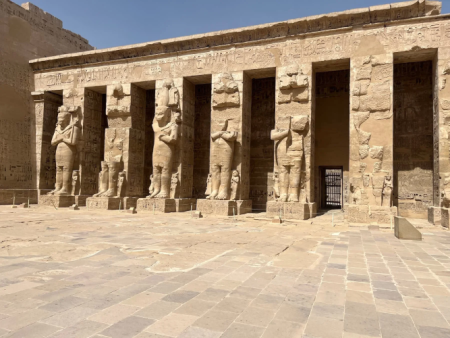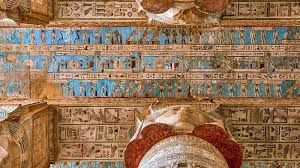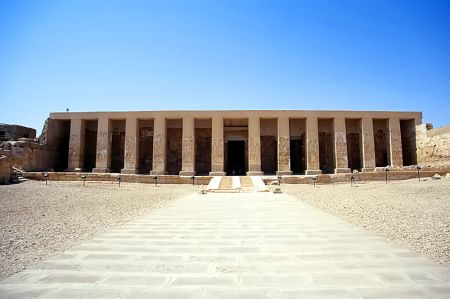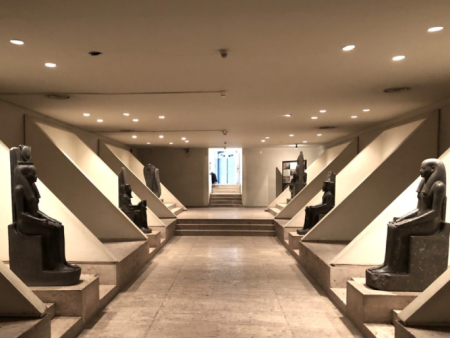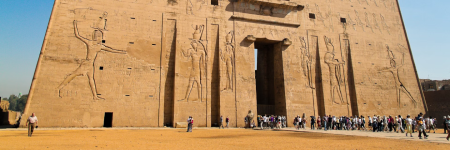Temple of Hatshepsut

Temple of Hatshepsut: The Timeless Jewel of Ancient Egypt’s West Bank
Perched dramatically at the base of towering limestone cliffs in Deir el-Bahari near Luxor City, the Temple of Hatshepsut stands as one of the most breathtaking architectural achievements of ancient Egypt. This mortuary temple, dedicated to Amun-Ra, immortalizes Queen Hatshepsut’s reign and her bold vision as one of history’s most remarkable female pharaohs. Every column, terrace, and relief tells a story of divine legitimacy, royal power, and architectural genius that continues to mesmerize travelers and historians alike. Built over 3,400 years ago, this masterpiece doesn’t just honor a ruler—it encapsulates Egypt’s artistic evolution and spiritual devotion. Its symmetry, harmony, and integration with the surrounding cliffs make it a marvel that defies time.
Visitors to the Temple of Hatshepsut are immediately struck by its grandeur. The temple’s design is unique—three expansive terraces connected by long ramps, blending seamlessly into the cliff face behind it. Unlike other mortuary temples of the New Kingdom, this structure emphasizes balance and aesthetic grace over brute scale. The temple complex once housed lush gardens, colorful reliefs illustrating Hatshepsut’s divine birth, and detailed carvings of her trade expeditions to the fabled Land of Punt. Today, it remains a must-see site for travelers exploring the West Bank of the Nile and the surrounding wonders, such as the Valley of the Kings and the Colossi of Memnon.
Whether you’re passionate about Egypt Excursions or deeply intrigued by ancient architecture, the Temple of Hatshepsut offers an unforgettable glimpse into Egypt’s golden age. It’s a masterpiece that bridges history, mythology, and innovation—an enduring symbol of Egypt’s spiritual and artistic heritage.
The Visionary Pharaoh Behind the Temple of Hatshepsut
Queen Hatshepsut, the mastermind behind this extraordinary monument, reigned during the 18th Dynasty, a period marked by prosperity and artistic flourishing. As the daughter of Thutmose I and the wife of Thutmose II, Hatshepsut initially ruled as regent for her stepson Thutmose III. But soon, she boldly proclaimed herself Pharaoh, an unprecedented act for a woman in ancient Egypt. Her rule challenged gender norms and redefined what leadership meant in the ancient world. Her temple, known as Djeser-Djeseru (“Holy of Holies”), was both an offering to the gods and a declaration of her divine right to rule.
Under her direction, the temple became a showcase of her political acumen and architectural vision. Reliefs within the sanctuary depict her divine conception and coronation, asserting her legitimacy as the chosen ruler of Egypt. Scenes of her legendary expedition to Punt highlight her role as a bringer of wealth and stability. Her reign is often remembered for peace, trade expansion, and monumental building projects—including parts of the Karnak Temple complex. Through the Temple of Hatshepsut, her legacy still resonates, symbolizing female empowerment thousands of years before the modern era.
Architectural Genius of Senenmut: Design and Innovation
The temple’s brilliant architect, Senenmut, was Hatshepsut’s trusted advisor and the creative genius behind the project. Together, they conceived an architectural marvel unlike anything seen before. The temple’s three terraces ascend in perfect harmony, connected by long ramps that guide visitors through a journey of spiritual elevation. Each level served a distinct ceremonial function, culminating in the inner sanctuary dedicated to Amun-Ra.
The alignment of the temple with the rising sun represents the unity between divine order and earthly power. Its colonnades, adorned with detailed reliefs, depict scenes ranging from Hatshepsut’s divine birth to her diplomatic triumphs. The structure’s limestone façade blends seamlessly into the cliffs, symbolizing the union between human craftsmanship and nature’s grandeur. This seamless integration inspired later architectural innovations across Egypt, influencing the design of structures such as the Luxor Temple.
Symbolism and Spiritual Meaning in Every Detail
Beyond its architectural splendor, the Temple of Hatshepsut carries profound religious symbolism. The temple’s east-west alignment mirrors the sun’s journey, reflecting Egypt’s belief in rebirth and eternity. The terraces symbolize stages of spiritual ascent, leading worshippers from the earthly realm to the divine presence of Amun-Ra. Carvings throughout the temple celebrate Hatshepsut’s divine lineage—her claim that Amun himself fathered her, granting her the sacred right to rule Egypt.
Each wall relief and sculpture conveys messages of divine connection, legitimacy, and balance. These themes reinforced the pharaoh’s divine authority and tied her reign to Maat—the ancient Egyptian concept of truth, harmony, and cosmic order. The temple was not just a monument; it was a statement of faith, leadership, and timeless devotion.
Restoration and Preservation of the Temple
Centuries of sandstorms, earthquakes, and human interference left the temple in ruins until modern restoration efforts resurrected its former glory. Archaeologists have meticulously restored much of the temple’s structure, reviving its colonnades, statues, and vibrant reliefs. The Polish-Egyptian Archaeological Mission continues to uncover new details about its construction and religious rituals. Visitors today can walk through the same pathways once trodden by priests and royal processions, witnessing the temple’s reborn magnificence.
How to Visit the Temple of Hatshepsut Today
The Temple of Hatshepsut lies on the west bank of the Nile, opposite Luxor. It’s easily accessible from the city by car, taxi, or as part of guided Egypt Travel Packages. Many visitors combine their trip with stops at nearby attractions such as the Avenue of Sphinxes and the Habu Temple. The best time to visit is early morning when the desert sun casts golden light on the cliffs, illuminating the temple’s intricate hieroglyphics in breathtaking detail.
Travelers interested in luxury experiences can explore the site as part of curated Egypt Luxury Tours or enjoy scenic routes through Egypt Nile Cruises, which often include excursions to Luxor’s iconic temples. The site’s visitor facilities, including shaded rest areas and interpretive panels, make exploration both comfortable and educational.
Fascinating Discoveries and Legends
The temple is filled with hidden stories and archaeological mysteries. Excavations have uncovered remnants of statues, offering tables, and even traces of ancient pigments that once made the reliefs vibrantly colorful. One of the most compelling discoveries is the depiction of the famous “Expedition to Punt,” showcasing exotic goods like incense, ivory, and gold—proof of Egypt’s far-reaching trade relations. Legends also surround Hatshepsut’s disappearance; after her death, her successor Thutmose III ordered many of her images defaced, attempting to erase her from history. Yet, her temple endured, preserving her legacy for eternity.
The Enduring Legacy of the Temple of Hatshepsut
Today, the Temple of Hatshepsut remains an enduring symbol of ancient Egypt’s grandeur and a tribute to one of its most visionary rulers. Its influence extends beyond architecture—it continues to inspire modern artists, historians, and leaders. As one of the crown jewels of Luxor’s archaeological landscape, it attracts millions of travelers who come to stand where a woman once redefined kingship and left an indelible mark on the sands of time.
FAQs about the Temple of Hatshepsut
1. Who built the Temple of Hatshepsut?
The temple was commissioned by Pharaoh Hatshepsut, Egypt’s powerful female ruler of the 18th Dynasty, and designed by her architect Senenmut. Together, they created one of the most extraordinary monuments of ancient Egypt.
2. What makes the Temple of Hatshepsut unique?
Unlike other mortuary temples, it blends perfectly with the surrounding cliffs at Deir el-Bahari. Its three-tiered terraces, harmonious symmetry, and exquisite reliefs make it an architectural masterpiece and a spiritual sanctuary.
3. What was the purpose of the Temple of Hatshepsut?
The temple served as a mortuary complex dedicated to Amun-Ra and a place of worship for Hatshepsut’s divine spirit. It commemorated her reign and celebrated her role as a divinely chosen ruler.
4. How can visitors reach the Temple of Hatshepsut?
The temple is located near Luxor on Egypt’s west bank. Visitors can access it by car, taxi, or guided tours, often included in curated Egypt Vacation Packages and Nile cruise itineraries.
5. What other attractions are near the Temple of Hatshepsut?
Nearby attractions include the Valley of the Kings, the Luxor Museum, and the Karnak Temple. Together, these sites form the heart of ancient Thebes, a UNESCO World Heritage treasure trove.





